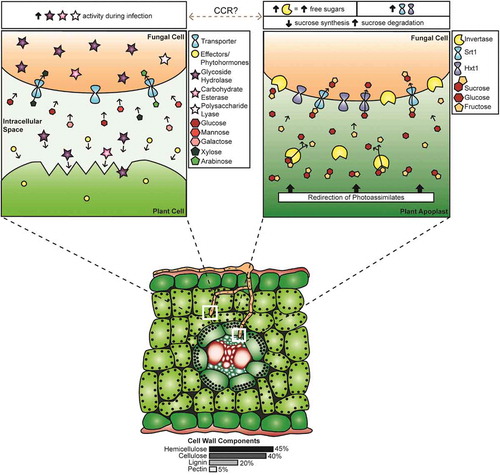Figures & data
Table 1. Up-regulated cell wall-degrading enzyme (CWDE) genes during pathogenic development of Ustilago maydis.
Table 2. Down-regulated cell wall-degrading enzyme (CWDE) genes during pathogenic development of Ustilago maydis.
Table 3. Pathogenesis and microarray expression data of Ustilago maydis sugar transporter family members.
Fig. 1 (Colour online) Diagrammatic representation of events related to carbon acquisition by Ustilago maydis during pathogenic growth in maize (Zea mays). (Bottom panel) Cross-section of a maize leaf, showing that fungal mycelia have penetrated the cuticle and epidermis, growing between and through the mesophyll cells. The upper mycelium is in the process of penetrating the next mesophyll cell while the lower mycelium has penetrated the bundle sheath and has grown between the phloem cells. The white boxes indicate the areas with expanded views. (Upper left panel) Expanded view of mycelium approaching a plant mesophyll cell. Ustilago maydis modifies the host physiology and suppresses defence responses through the action of effectors and phytohormones, while CAZymes act on the cell wall. The approximate proportions, based on the comprehensive U. maydis CAZyme list in Supplementary Table 1, of GH (~76%), CE (~23%) and PL (<1%) enzymes are indicated by the number of coloured stars. These enzymes depolymerize cell wall components, releasing hexose and pentose sugars which are taken up by the fungus via transporters; the proportion of cell wall components are indicated below the lower panel. The text box above this panel indicates increased CWDE activity during infection. (Upper right panel) Expanded view of carbon uptake by a mycelium interacting with the phloem tissue, representing the results of U. maydis creating sink tissue in the leaves. Sucrose moves through the phloem and is available in the leaf vasculature for direct uptake by the fungus via Srt1. Alternatively, sucrose is acted upon by cell wall or vacuolar invertases to yield glucose and fructose, which are transported into the fungus via the monosaccharide sugar transporter Hxt1. The text box above this panel indicates the role of CCR in this process; increased invertase and transporter activity, increase in free sucroses, decrease in sucrose synthesis genes, and an increase in sucrose degradation genes is observed in infected tissue. The switch between methods of carbon acquisition by the fungus, which is indicated by the grey dashed line, could be mediated by CCR systems.

Table 4. Summary of Ustilago maydis infection of Zea mays leaves at various stages of growth.
